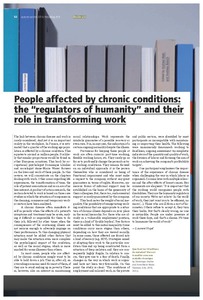People affected by chronic conditions: the “regulators of humanity” and their role in transforming work [Book review - Que font les dix millions de malades ? Vivre et travailler avec une maladie chronique]

2016
14
52
chronic diseases ; employability ; return to work ; trade union document
Occupational qualification and job placement
English
"The link between chronic disease and work is rarely considered. And yet it is an important reality in the workplace. In France, it is estimated that a quarter of the working age population is affected by a chronic condition. This equates to around 10 million people. It is likely that similar proportions would be found in other European countries. This book by occupational psychologist Dominique Lhuilier and sociologist Anne-Marie Waser focuses on the lives and work of these people. In this review, we will concentrate on the chapters dealing with work. Other areas regarding life experiences, the transformation of time, the role of patient associations and so on are of no less interest. A product of action research, the section devoted to work is based on three case studies in which the situation of companies in the cleaning, commerce and temporary worker sectors have been analysed.
A chronic disease often manifests itself in periods when the effects of a patient's symptoms and treatment may be acute, making it difficult or impossible for them to do their job, followed by other times when the consequences of the continuing illness are not serious enough to adversely impinge on their performance. To this changing physical situation must be added other factors that may make the situation even more complex: the psychological impact of the condition, as well as the social stigma, which is more marked for some illnesses than others.
In most cases, people who are affected by chronic conditions simply want to be able to hold down a job. This is, after all, an overriding economic need for most of them, if they are to avoid ending up in poverty. There is, however, also an interest in maintaining social relationships. Work represents the symbolic guarantee of a possible recovery or even cure. It is, in any case, the indication of a certain ongoing normality despite the illness.
Provisions for keeping these people at work are often cursory: part-time working, flexible working hours, etc. They rarely go as far as to profoundly change the person's actual working conditions. They remain focused on an individual approach: it is the person themselves who is considered as being of functional impairment and who must make a request to the company, without any great guarantees in terms of rights. Moreover, numerous forms of informal support may be established on the basis of the generosity of their colleagues. But, there too, such essential support is rarely guaranteed by the company.
This book notes the weight of social inequality. The possibility of renegotiating working conditions that are appropriate to a situation of chronic illness depends on your place in the social hierarchy. For those who are already in a vulnerable employment position, there is a kind of "double burden". Two factors must be added to this initial inequality. Some conditions carry more stigma than others, depending on how they are viewed socially. In some cases, those affected are forced into a kind of secrecy (e.g. HIV). Strategies aimed at adapting their work to the particular condition thus end up being constructed from a situation of deep isolation and they are consequently highly fragile. In relation to cancer, they give rise to a fear of death. Finally, changes in the way in which work is organised have not been very favourable. On this point the study is clear: "The conditions of employment and salaried work, in the private and public sectors, were identified by most participants as incompatible with maintaining or improving their health. The following were unanimously denounced: working to deadlines, ongoing assessment via simplistic indicators of the quantity and quality of work, the division of labour and focusing the aim of work on achieving the company's profitability targets".
One participant emphasises the importance of the experience of chronic disease when challenging the way in which labour is organised. Corinne lives with multiple sclerosis and the after-effects of breast cancer. Her comments are eloquent: "It is important that the working world recognises people with disabilities. They are the humanity regulators of our society. We're not robots! In the world of work, they just want you to be efficient, no more (…). Those who are ill form a sort of barometer. Others refuse to accept it, they turn their backs. But that's clearly wrong, no-one is invincible. People are under pressure at work these days, and that's a shame. It's time to humanise the world of work!" — Laurent Vogel"
Digital;Paper
See also
-
[Book]
Que font les dix millions de malades ? Vivre et travailler avec une maladie chronique
/ 1 ; 1.
Editions Erès, 2016. - 340 p.
ISBN 978-2749249957
-
[Article]
Les personnes affectées par des maladies chroniques : des régulateurs d'humanité pour transformer le travail [Book review - Que font les dix millions de malades ? Vivre et travailler avec une maladie chronique]
/ 1.
HesaMag, 2016, n° 14. - 52
The ETUI is co-funded by the European Union. Views and opinions expressed are however those of the author(s) only and do not necessarily reflect those of the European Union or the ETUI.